|
|
 |
Fiche d'espèce de Copépode |
|
|
Calanoida ( Ordre ) |
|
|
|
Clausocalanoidea ( Superfamille ) |
|
|
|
Aetideidae ( Famille ) |
|
|
|
Euchirella ( Genre ) |
|
|
| |
Euchirella maxima Wolfenden, 1905 (F,M) | |
| | | | | | | Syn.: | Euchirella simplex Esterly, 1911 (p.320, Descr.F, figs.F); Sewell, 1948 (p.556, 563); Brodsky, 1950 (1967) (p.178, figs.F); in CalCOFI regional list (MDO, Nov. 2013; M. Ohman, comm. pers.)
E. grandicornis (M): C.B. Wilson, 1950 (p.224, fig.M, no F) | | | | Ref.: | | | Wolfenden, 1905 a (p.18, Descr.F, figs.F); Farran, 1908 b (p.38); A. Scott, 1909 (p.57, figs.F, Rem.); Wolfenden, 1911 (p.238, figs.F); With, 1915 (p.127, figs.F,M); Sars, 1925 (p.75, figs.F,M); Sewell, 1929 (p.107, 112, figs.juv.); Rose, 1933 a (p.106, figs.F,M); Jespersen, 1940 (p.25); Sewell, 1947 (p.69, 88, figs.F, non M); C.B. Wilson, 1950 (p.225, figs.F,M); Vervoort, 1952 f (n°47, p.4, figs.F,M); ? Grice, 1962 (p.196, figs. juv.5M); Vervoort, 1963 b (p.147, Rem.); Owre & Foyo, 1967 (p.47, figs.F,M); Tanaka & Omori, 1969 (p.48, ? no M); 1969 a (p.157, figs.F); Vaupel Klein, 1972 (p.501, 504, figs.F,M); Park, 1976 a (p.112, figs.F,M); 1978 (p.149, figs.M); Bradford & Jillett, 1980 (p.33); Vaupel Klein, 1984 a (p.40, figs.F, Table II: characters, Rem); Markhaseva, 1996 (p.156, figs.F,M); Vaupel Klein, 1998 a (p.386: Table 1, fig.F, fig.5); Bradford-Grieve & al., 1999 (p.879, 921, figs.F,M); Mulyadi, 2001, p.817, figs.F, Rem.); Mulyadi, 2004 (p.46, figs.F, Rem.); Vives & Shmeleva, 2007 (p.565, figs.F,M, Rem.) | 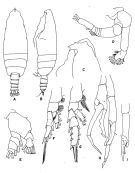 issued from : T. Park in Antarctic Res. Ser. Washington, 1978, 27. [p.150, Fig.30]. Male: A, habitus (dorsal view); B, idem (left lateral side); C, forehead (left lateral); D, A2; E, mandibular palp; F, P1; G, P2; H, P5; I, exopod of left P5 (medial). P1-5: legs (anterior view). Nota from Markhaseva (1996, p.156): Cephalothorax nearly 6-7 times longer than urosome. Rostrum small, better developed than in females. Endopod of A2 1/4 of exopod length; endopodal segment 2 external lobe with 6 setae and internal lobe with 6 long and 1 small short setae. Endopodal segment 2 of Md with 8 setae. Mx1 and Mx2 setation severely reduced.
|
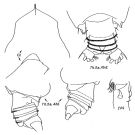 issued from : E.L. Markhaseva in Proc. Zool. Inst. RAN, St. Petersburg, 1996, 268. [p.159, Fig.121]. Female (specimen from SE Pacif.). Ce: crest of the forehead (dorsal and lateral, respectively); CP4: coxopod of P4.
|
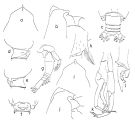 issued from : T. Park in Contr. Mar. Sci., 1976, 20. [p.112, Fig.4] Female: a, b, forehead (dorsal and lateral, respectively); c, posterior part of metasome and urosome (dorsal); d, e, f, posterior part of metasome and genital segment (right side, left side and ventral, respectively); g, A2; h, coxa of fourth leg (posterior). Male: i, j, forehead (dorsal and lateral); k, fifth pair of legs (anterior); l, distal part of exopod of left fifth leg (medial).
|
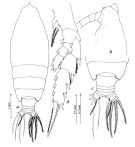 issued from : Mulyadi in Crustaceana, 2001, 74 (9). [p.817, Fig.4]. Female (from Flores Sea): a, habitus (dorsal); b, head (left lateral side); c, last thoracic segment and urosome (dorsal); d, P4. Nota: Prosome about 5.9 times longer than urosome. A1 reaching distal end of genital somite (when folded backwards).
|
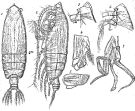 Issued from : G.O. Sars in Résult. Camp. Scient. Prince Albert I, 69, pls.1-127 (1924). [Pl.XXII, figs.1-7]. Female: 1, habitus (dorsal); 2, idem (lateral left side); 3, forehead (lateral); 4, basipodal segment of P4; 5, posterior part cephalothorax (lateral left side). Male: 6, forehead (lateral); 7, P5.
|
 issued from : R.B.S. Sewell in The John Murray Expedition, 1933-34, Scientific Reports, VIII (1), 1947. [p.90, Fig.19, C, F]. Female (from Arabian Sea): C, Mx2; F, P2. Nota: Proportional lengths of cephalothorax and abdomen as 4.8 to 1. The proportional lengths of the various segments of the body (cephalon to caudal rami) as 411:137:88:87:83:13:68:32:28:20:33=1000. Forehead with a high crest and the rostrum small and stout. Head and 1st pediger segment fused, but in a stained specimen the line of fusion can still be seen, especially in the lateral region. 4 th and 5 th fused, but the 5 th forms a rounded lappet on the posterior thoracic margin. A1 23 segmented (segments 8-9 and 24-25 fused). In A2 the 1 st basal segment bears a row of long hairs on its inner aspect; endopod much reduced and the proportioal lengths of the two rami as 27 to 75; in the endopod the outer lobe of the terminal segment with 5 setae, and the inner lobe with 3 large and 2 small setae; segment 1 bears a conical process without seta. Md with a powerful bithing blade.
|
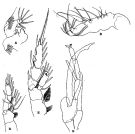 issued from : R.B.S. Sewell in The John Murray Expedition, 1933-34, Scientific Reports, VIII (1), 1947. [p.90, Fig.19, A, B, D, E, G]. This male belongs to another species not identified. Male: A, Mx1; B, mx2; D, P1; E, P2; G, P5. Nota: Proportional lengths of the cephalothorax and urosome as 79 to 21. Head and ist pedigerous segment fused, 4th and 5th fused. The proportional lengths of the various egments of the body (cephalon to caudal rami) as 528:77:65:94:50:52:48:37:11:35 = 1000. Posterior thoracic margin rounded. Urosomal segments 2, 3 and 4 fringed posteriorly with a palisade of delicate spines. Anal segment almost completely telescoped into the 4th, and bears a tuft of hairs ventrally. A1 reaches back to the posterior margin of the 2nd urosomal segment. In the left, segments8, 9 and 10 fused, and so are segments 12, 13, 14, 15, and 24, 25 respectively; in the right segments 20; 21 fused, segment 3 bears a long seta. In A2 the two rami approximately equal length, the 1st basal segment bears a row of hairs; the 1st and 2nd segments of the exopod separate; the distal segment of endopod bears 8 and 7 setae respectively on the two lobes. In Mx1 the 3 inner lobes greatly reduced and devoid of any spines or setae; the 2nd basal segment bears on its inner margin 2 very unequal setae, and beyond this are 2 distinct segments, of which the 1st bears on its inner margin 2 lobes each bearing a proximal small and a distal long seta; the distal segment is small and bears 4 setae; the exopod well-developed carries 11 setae, and the outer lobe also well developed bears 5 large and 1 small setae. Mx2 is similar to that of E. curticauda as figured by With (1915, Pl.IV, fig.3h). In P2 the marginal spine of the 2nd segment of the exopod is of remarkable length, and reaches nearly to the distal end of the 2nd spine of the 3rd segment (in this respect tis specimen differs radically from the one examined by With.
|
 issued from : A. Scott in Siboga-Expedition, 1909, XIX a. [Plate XII, Figs.12-20]. Female (from Halmahera Sea and banda Sea): 12, habitus (dorsal); 13, forehead (lateral); 14, last thoracic and genital segments (left side); 15, rostrum (frontal view); 16, A1; 17, A2; 18, Mx1; 19, P4 (basal portion only).
|
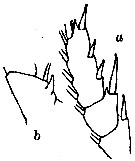 issued from : R.N. Wolfenden in Die Marinen Copepoden der Deutschen Südpolar-Expedition 1901-1903, 1911. [p.239, Fig.24]. Female: a, exopod of P2; b, basipod segment of P4.
|
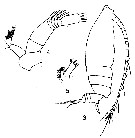 issued from : R.N. Wolfenden in Die Marinen Copepoden der Deutschen Südpolar-Expedition 1901-1903, 1911. [Pl.XXVIII, Fig.3-5]. Female: 3, habitus (lateral); 4, A2; 5, Mx1 (outer and inner rami).
|
 issued from : J.C. von Vaupel Klein in Crustaceana, Supplt 9, Studies on Copepoda, III, 1984. [p.61, Fig.4, e]. Female: e, triangular crest on forehead (left lateral side).
|
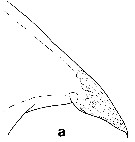 issued from : J.C. von Vaupel Klein in Crustaceana, Supplt 9, Studies on Copepoda, III, 1984. [p.42, Fig.2, a]. Female: a, large spine on basipodite 1 of P4 (showing composition of some 8 slender, coalescent spines (posterior view of left leg). Nota: As apparent, this structure in reality is composed of some 8-9 thin, completely coalescent spines, inserting on one common base. , for Tanaka & Omori (1969, p.157, fig.1g) the outgrowth itself covers 5 spinules. Apparently, the number of fused spines may vary.
|
 issued from : J.C. von Vaupel Klein in Crustaceana, Supplt 9, Studies on Copepoda, III, 1984. [p.75, Fig.13, h]. Female: h, patch of spinules adjacent to the insertions of the setae of group III on basipodite 1 of Mxp (detail of left appendage in lateral view). Nota: More than 120 sharp, slender spinules in a large extensive patch.
|
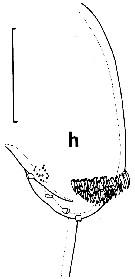 issued from : J.C. von Vaupel Klein in Crustaceana, Supplt 9, Studies on Copepoda, III, 1984. [p.76, Fig.14, h]. Female: h, arrangement of spinules on the lateral tubercle of endopod of P1 (left appendage, anterior face). Scale bar 0.067 mm.
|
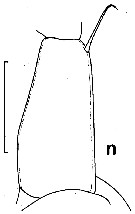 issued from : J.C. von Vaupel Klein in Crustaceana, Supplt 9, Studies on Copepoda, III, 1984. [p.63, Fig.5, n]. Female: n, setal armature of endopodite 1 of A2 (note: one seta of moderate length). Scale bar 0.2 mm.
|
 issued from : C.O. Esterly in Univ. Calif. Publs Zool., 1911, 6 (14). [Pl.26, Fig.10]. As Euchirella simplex. Female (from San Diego Region): 10, habitus (lateral). The head is produced below into a minute point (rostrum). A1 23-segmented, reach a little beyond the last thoracic segment. The spines on the 1st basal of P4 are lacking.
|
 issued from : C.O. Esterly in Univ. Calif. Publs Zool., 1911, 6 (14). [Pl.29, Figs.50, 62]. As Euchirella simplex. Female: 50, forehead (lateral, right side); 62, part of thoracic segment and urosome .
|
 issued from : O. Tanaka & M. Omori in Publ. Seto Mar. Biol. Lab., 1969, XVII (3). [p.158, Fig.1). Female (from Izu Region, Japan): a-b, habitus (dorsal and left lateral, respectively); c, forehead (lateral); d-f, last thoracic segment and urosome (dorsal, right and left lateral, respectively); g, 1st basal segment of P4.
|
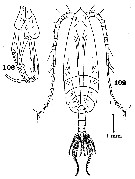 issued from : C.B. Wilson in Bull. U.S. natn. Mus., 1950, 100, 14 (4). [Pl. 10, Figs.102, 106]. As Euchirella grandicornis. Male (from 18°47'S, 89°26'W): 102, habitus (dorsal); 106, P5.
|
 issued from : C.B. Wilson in Bull. U.S. natn. Mus., 1950, 100, 14 (4). [Pl. 10, Figs.102, 106]. As Euchirella grandicornis. Male (from 18°47'S, 89°26'W): 102, habitus (dorsal); 106, P5.
|
 issued from : C.B. Wilson in Bull. U.S. natn. Mus., 1950, 100, 14 (4). [Pl. 23, Fig.339]. Male (from 10°00'22''S, 124°45'06'''E): 339, P5.
|
 issued from : J.C. von Vaupel Klein in Zool. Verh. Leiden, 1998, 323. [p.387, Fig.2]. Measurements taken from maxilliped: Ba1 = length of basipodal segment 1; Ba2 = length of Ba2; S = length of the longest seta of the only ramus (endopodite). measurements used to compare with other species (tables 1 and 2) in view of the speciation (see discussion after Von Vaupel Klein (1998, pp.389-397) in the genus Euchirella.
|
 issued from : J.C. von Vaupel Klein in Zool. Verh. Leiden, 1998, 323. [p.386, Table 1]. Dimensions of adult females of E. curticauda and E. maxima, allegedly relevant in niche separation. 1/ See Material and methods (Von Vaupel Klein, 1998, pp.385-387); 2/ Present collections: 3.45-4.15 mm; 3/ Present collections: 6.5-8.05 mm; 4/ From Von Vaupel Klein (1984, p.93).
|
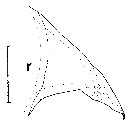 issued from : J.C. von Vaupel Klein in Crustaceana, Supplt 9, Studies on Copepoda, III, 1984. [p.80, Fig.16, r]. Female: r, medial spine on the posterior face of basipodal segment 1 of left P4. Scale bar 0.1 mm. Nota: about 8 slender, coalesced spines together form a large, flat plate.
|
 issued from : J.C. von Vaupel Klein in Crustaceana, Supplt 9, Studies on Copepoda, III, 1984. [p.69, Fig.9, h]. Female: h, complement of terminal setae on the 2nd inner lobe of basipodal segment 1 of right Mx1 (details of right appendages in anterior view; to the posterior side 2 relatively stout setae are always present, which are combined bipectinate and spinulose; both anterior setae bipectinate/spinulose, similarly as in Chirundinella magna).
Scale bar: 0.2 mm.
|
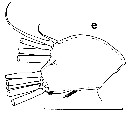 issued from : J.C. von Vaupel Klein in Crustaceana, Supplt 9, Studies on Copepoda, III, 1984. [p.65, Fig.6 e]. Euchirella maxima: a, Setal armature of endopodte 2+3 of A2. Conditions are expressed are expressed in formulae as follows: number of setae in regular row on proximal lobe / relative development of seta in position no. 9 on this lobe / number of setae in approximately linear row on terminal lobe / relative development of appendicular seta no. 7 and its supporting pedestral (absent, vestigial, moderate or well developed: see Table I, p.87 and Table II, p.93). Upper and lower lobes = proximal and terminal lobes (details of right appendage shown in medial aspect). Scale bar = 0.133 mm. Nota: Condition 5/2/5/2.
|
 Euchirella maxima Euchirella maxima female: 1 - Genital segment asymmetrical. 2 - Crest present. 3 - Coxopodite of P4 with 1 spine. 4 - Posterior corners of last thoracic segment slightly asymmetrical, not rounded (dorsal and lateral view). Endopodal segment 2 of A2 with 5 setae on each (internal and external) lobe.
|
 Euchirella maxima Euchirella maxima male: 1 - P5 always biramous. Endopod of left P5 well developed, nearly as long as exopodal segment 1. Exopodal segment 2 and endopod of right P5 are not elongated and not sharpened into their distal parts, do not form tongs. Endopod of right P5 not exceeding distal border of exopodal segment 1. 2 - Crest present. Rostrum not large. 3 - Terminal part of exopodal segment 2 of right P5 without tooth.
|
 issued from : J.C. von Vaupel Klein in Crustaceana, Supplt 9, Studies on Copepoda, III, 1984. [p.66, Fig.7, d]. Euchirella maxima d, A2 arrangements of spinules and hairs on the posterior edge of endopodite 2+3 (right appendage of medial view ): 6 short spinules idistally and a proximal group of 5 long, slender spinules.
|
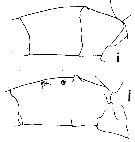 issued from : J.C. von Vaupel Klein in Crustaceana, Supplt 9, Studies on Copepoda, III, 1984. [p.66, Fig.7, i, j]. Euchirella maxima: Structural feature of exopodite 1 and exopodite 2 of A2 (lateral aspects of left appendages and medial views of right antennal parts; compare with Fig.7n which represents left A2 medial face drawn from a lateral view). i, lateral; j, medial. Nota: 3 well developed anterior outgrowths. Degree of fusion of exopodites 1 and 2.: suture largely complete laterally, nearly absent medially.
|
 Issued from : J.C. von Vaupel Klein in Crustaceana, (Supplement) 9, 1984. [p.93, Table II ]. Euchirella maxima Female: Datamatrix stating observed states of characters from Table I (p.87-90) presently examined; nos. refer to the input nos. used in Table I (see to the family Aetideidae).
|
 Issued from : J.C. von Vaupel Klein in Crustaceana, (Supplement) 9, 1984. [p.94, Table II (cont' d) ]. Euchirella maxima Female: Datamatrix stating observed states of characters from Table I (p.87-90) presently examined; nos. refer to the input nos. used in Table I (see to the family Aetideidae).
|
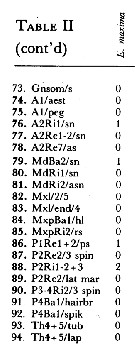 Issued from : J.C. von Vaupel Klein in Crustaceana, (Supplement) 9, 1984. [p.95, Table II (cont' d) ]. Euchirella maxima Female: Datamatrix stating observed states of characters from Table I (p.87-90) presently examined; nos. refer to the input nos. used in Table I (see to the family Aetideidae).
| | | | | Ref. compl.: | | | Sewell, 1948 (p.330, 500, 520, 531, 532, 534, 538, 545); De Decker & Mombeck, 1964 (p.12); Fleminger, 1967 a (tabl.1); Grice & Hulsemann, 1967 (p.15); 1968 (tab.2); Dowidar & El-Maghraby, 1970 (p.268); Roe, 1972 (p.277, tabl.1, tabl.2); 1972 a (p.340); Bainbridge, 1972 (p.61, Appendix Table III: occurrence); Vives, 1982 (p.291); Shih Young, 1995 (p.67); Chen Y.-Q., 1986 (p.205, Table 1: abundance %, Table 2: vertical distribution); Suarez-Morales & Gasca, 1998 a (p107); Lapernat, 2000 (tabl. 3, 4); Razouls & al., 2000 (p.343, Appendix); d'Elbée, 2001(tabl. 1); Holmes, 2001 (p.47); Hwang & al., 2007 (p.23); Galbraith, 2009 (pers. comm.); Park & Ferrari, 2009 (p.143, Table 5, Appendix 1, biogeography); C.E. Morales & al., 2010 (p.158, Table 1); Hidalgo & al., 2010 (p.2089, Table 2); in CalCOFI regional list (MDO, Nov. 2013; M. Ohman, comm. pers.) | | | | NZ: | 16 | | |
|
Carte de distribution de Euchirella maxima par zones géographiques
|
| | | | | | | | | | | | | | |  issued from : J.C. von Vaupel Klein in Zool. Verh.Leiden, 1998, 323. [p.392, Fig.6]. issued from : J.C. von Vaupel Klein in Zool. Verh.Leiden, 1998, 323. [p.392, Fig.6].
Map showing the distributional areas of E. curticauda Giesbrecht, 1888 and E. maxima Wolfenden, 1905, respectively; note the large overlap in ranges. Antarctic convergence i(AC) |
| | | | Loc: | | | sub-Antarct. (SE Pacif.), South Africa (E), Tristan da Cunha Is., off Angola, G. of Guinea, off Lagos, off E St. Paul Is., off NW Cape Verde Is., Canary Is., off Madeira, Azores, G. of Mexico, Florida, Bay of Biscay, E Medit. (Alexandria), off Ireland (S & W), S Iceland, Faroe Is., G. of Aden, Arabian Sea, G. of Oman, Laccadive Is., off Sri Lanka (E & SW), Indian, Bay of Bengal, Indonesia-Malaysia, Flores Sea, Philippines, China Seas (South China Sea), S Taiwan, Japan (Izu), Vancouver Is., California, ? Pacif. (equatorial), off Peru, off Juan Fernandez Is., Chile (S, Concepcion).
Type locality: Atlantic (tropical). | | | | N: | 47 | | | | Lg.: | | | (1) F: 7,4; (5) F: 7,2; (7) F: 7,8; M: 6,7; (10) F: 8-7,5; (11) F: 7,25; M: 7,02; (14) F: 7,5; M: 7,35-6,1; (20) M: 6,58; (29) F: 6,5-6,1; (37) F: 8,7-6,5; M: 7,35-6,1; (110) F: 7,6-7,35; ? M: 6,9; (137) M: 7; (140) F: 7,5-7; (143) F: 6,36; (199) F: 7,68; (235) F: 7,33-6,92; M: 6,16; (413) F: 7,4-6,5; (855) F: 6,08; (1122) F: 6,08; (1257) F: 6,5-7,15; {F: 6,08-8,70; M: 6,10-7,35}
The Mean female size is 7.141 mm (n = 23; SD = 0.6730), and the mean male size is 6.726 mm (n = 10; SD = 0.4827). The size ratio (male : female) is probably near of 0.90. | | | | Rem.: | épi-méso-bathypélagique .
Sampling depth (sub-Antarct.) : 0-300 m.
Pour Park (1978) les mâles indiqués par Sewell (1947) et Tanaka & Omori (1969 ) appartiendraient à une autre espèce. | | | Dernière mise à jour : 22/02/2021 | |
|
|
 Toute utilisation de ce site pour une publication sera mentionnée avec la référence suivante : Toute utilisation de ce site pour une publication sera mentionnée avec la référence suivante :
Razouls C., Desreumaux N., Kouwenberg J. et de Bovée F., 2005-2025. - Biodiversité des Copépodes planctoniques marins (morphologie, répartition géographique et données biologiques). Sorbonne Université, CNRS. Disponible sur http://copepodes.obs-banyuls.fr [Accédé le 01 janvier 2026] © copyright 2005-2025 Sorbonne Université, CNRS
|
|
 |
 |































